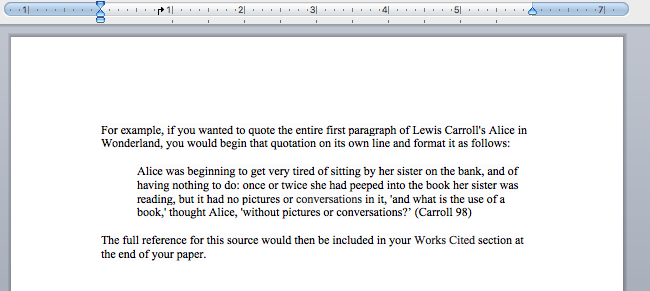MLA style requires that quotations of more than four lines be formatted as block quotations (block quotation are also used when quoting more than three lines of verse).
The following section explain how to use an MLA block quote, followed by an example of a block quote within an essay.
When to Use a Block Quotation
A typical quotation is enclosed in double quotation marks and is part of a sentence within a paragraph of your paper. However, if you want to quote more than four lines of prose (or three lines of verse) from a source, you should format the excerpt as a block quotation, rather than as a regular quotation within the text of a paragraph. Most of the standard rules for quotations still apply, with the following exceptions: a block quotation will begin on its own line, it will not be enclosed in quotation marks, and its in-text citation will come after the ending punctuation, not before it.
Example: MLA Block Quotation
Block quotation: An example of a properly formatted block quotation
Spacing and Alignment
The entire block quotation should be indented half an inch from the left margin. The first line of the excerpt should not be further indented, unless you are quoting multiple paragraphs—in which case the first line of each quoted paragraph should be further indented 0.25 inches.
To better visually distinguish a block quotation from the surrounding text, be sure to leave an extra (blank) line both above and below your block quotation.
If quoting more than three lines of verse, maintain the original line breaks.
Summary Points
- A regular quotation is part of a sentence within a paragraph in your paper; however, for longer quotations (more than four lines of prose, or more than three lines of verse), format the excerpt as a block quotation.
- A block quotation begins on its own line, is not enclosed in quotation marks, and—if applicable— has an in-text citation after the final punctuation.
- Block quotations are double-spaced, like the rest of your paper, and indented half an inch from the left margin.
License and Attribution

